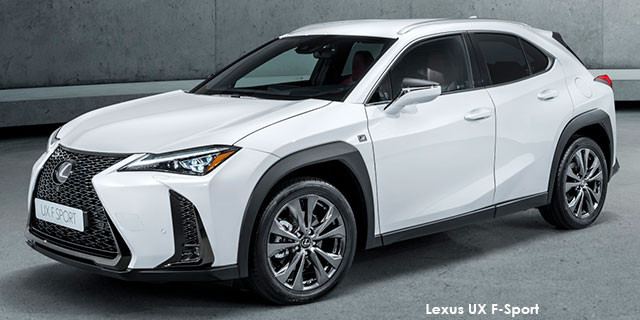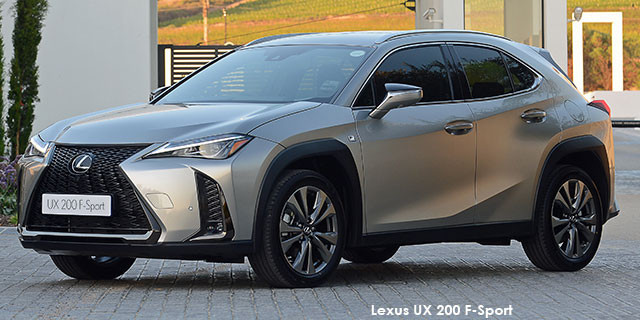The UX scores some misses but there’s an undeniable charm to Lexus’ new boutique crossover...
The abbreviation UX is most commonly associated with “user experience”, an apt descriptor when assessing Lexus’ new midsize crossover. The UX trades most heavily on how it makes its user feel, from their response to the challenging design, to the wonderful tactility of the cockpit and how the vehicle moves down the road. On a majority of fronts, the UX elicits a positive reaction. But some characteristics may see users turning up their nose…
Launched in South Africa earlier in 2019, the UX range encompasses three variants. Ringing in the line-up is the UX200 EX, which sports a brand-new 2,0-litre naturally aspirated powertrain coupled with an intriguing transmission: a continuously variable setup alongside a single gear engaged on pull-aways for smooth progress. Mid-pack you’ll find the UX250h hybrid in SE trim grade. It pairs a petrol unit with two electric motor-generators on each axle. Combined output is 130 kW, just units more than the UX200.
At the top of the UX family tree sits this UX200 F Sport, which has the same drivetrain as the entry-level model but an additional list of standard spec as long as an S-Class’. Included in the toy tally are such big-ticket items as adaptive variable suspension; power-adjustable seats; keyless entry and start; adaptive LED headlamps; a 13-speaker Mark Levinson audio system; adaptive cruise control; satellite navigation; 360-degree parking cameras; and a full suite of safety systems including blind-spot monitoring, lane-departure warning and automatic correction, plus eight airbags. Specify rivals such as BMW X2 and Jaguar E-Pace to an equivalent level and you’re facing a frankly scary sticker price.
What those vehicles have, though – and the UX200 lacks – is a turbocharger. Thanks in part to a high compression ratio of 13,0:1 and direct injection, Lexus claims this is one of the most efficient engines of its displacement. That statement certainly bore fruit on our fuel run, where the Lexus posted an average fuel-consumption figure of just 6,50 L/100 km.
However, while frugality is important, buyers of a premium boutique crossover costing nearly R730 000 expect effortless performance, too. Whereas the 2,0-litre is impressively hushed and smooth, and the CVT is one of the better such transmissions thanks to that mechanical gear set, performance from a standstill is middling; our benchmark 0-100 km/h sprint took nearly 11,0 seconds. In-gear acceleration, though, is slightly more impressive but the UX200 is still notably slower to overtake tardier vehicles than its turbocharged competition.
Where it trumps them is in its detailing, both outside and in. Showcasing a slightly more subdued version of Lexus’ familiar spindle grille – studded with intricate individual L-shaped pieces on the F-Sport, each a different size to the next – slit-like headlamps and L-shaped tail units standing proud of the fenders (good thing it has that useful camera system), the UX looks like a Lexus, certainly, but also somehow more youthful and contemporary (and odd: those wheelarches, for example). Perfect for capturing the attention of its fickle target audience.
They’re guaranteed to love the interior once they clap eyes on it. This test vehicle’s passenger cell is trimmed in tactile Flare Red leather extending to the doors and dashboard, which pairs remarkably well with the Terrane Khaki body paint, one of 13 hues. Perceived quality is as you’d expect – exemplary – although some testers noted more basic plastic surfacing on the rear doors than those in front.
Accompanying the 10,25-inch central infotainment screen sitting atop the dashboard is an eight-inch TFT version ahead of the driver, an inch larger than the version used on other models. Together with the now-customary Shrek’s ears knobs sprouting from the instrument cowl, there’s a deliberate resemblance to the cockpit layout of the revered LFA supercar. The screens are clear and crisp, but we’ll continue criticising Lexus’ Remote Touch Interface for as long as it’s in use. The trackpad simply isn’t user-friendly, no matter how judiciously you tweak the responsiveness settings; other brands do a better job of giving the driver and passenger access to the infotainment system. Before we shift to voice and gesture commands as the only form of interaction with a car, Lexus should consider changing to a touchscreen or scroller, à la BMW, to supplement the existing voice control. But, my, it gets the sound system right; the Mark Levinson setup is tremendously powerful and the speakers don’t set the door trims abuzz because the vehicle’s so exquisitely built.
Aft, there’s just about enough head- and legroom for two adults (an X2 has 70 mm extra clearance between the seats) but the boot measures 192 litres, not enough to swallow two large suitcases.
You might forgive the UX its practicality foibles once those intricately designed 18-inch wheels start moving. Built on the same chassis as the excellent Toyota C-HR and Prius, the UX200 F Sport adds Lexus’ Adaptive Variable Suspension with 650 stages of damping force reactive in milliseconds to road surfaces and driving conditions. It rides with an assuredness missing from the more highly strung X2, the underbody keeping close contact with the road without feeling over-sprung. This despite the standard fitment of less-yielding run-flat tyres. Overall, this is an accomplished chassis with a neutral balance that washes into mild understeer easily curable with a gentle lift of the throttle. The steering, too, is well judged, though entirely lifeless as is the norm in this segment.
Braking performance is impressive without being outstanding, the ventilated front brakes and solid rears bringing the vehicle to a halt in an average of less than three seconds.
TEST SUMMARY
Our work’s cut out for us when appraising vehicles such as the Lexus UX. Fashionable crossovers are often bought more for their emotional resonance than for any rational reasons. As such, considerations like pinched cabin space and a small boot might bear less importance than the way the UX looks (interesting), is finished (beautifully) and drives (really well despite the engine not being at the cutting edge). The UX200 F Sport certainly scores more wins than losses, and is an exciting new addition to the burgeoning crossover fold.
We’d exercise careful consideration when choosing a UX, however. To the CAR team, both the UX200 XE and UX250h SE represent better value than this F Sport.
ROAD TEST SCORE

|

|

|

|

|

|
Original article from Car
See Full Lexus UX price and specs here















